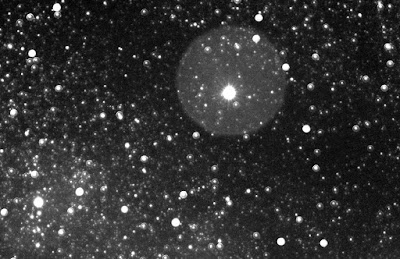 |
| NGC 7000/IC 5070 in H alpha |
Type: Emission nebulae
Constellation: Cygnus
Distance: 1,500 light years
Equipment: SX Pro 694, Samyang 135mm lens@ F2, Vixen GPDX mount, guiding with Lodestar X2/PHD
Date: September 14th. 2020
Subframes: 6 x 300s Ha, no flats, no darks (hot pixel removal in Astroart).
 |
| Stellarium map showing field of view |
On December 12, 1890, the German astrophotographer Max Wolf noticed the characteristic shape of the eastern part of the nebula on a long-exposure photograph, and dubbed it the North America Nebula. In addition, in a paper of June 10, 1891 he described the region near that nebula as photographed on a 3 hour plate taken on June 1 of that year. However, an accurate position of the Pelican Nebula had to wait until Sep 7, 1899, where the object was described by British astronomer Thomas Espin.
In his study of nebulae on the Palomar Sky Survey plates in 1959, American astronomer Stewart Sharpless realised that the North America Nebula is part of the same interstellar cloud of ionised hydrogen as the Pelican Nebula, separated by a dark band of dust, and listed the two nebulae together in his second list of 313 bright nebulae as Sh2-117. American astronomer Beverly T. Lynds catalogued the obscuring dust cloud as L935 in her 1962 compilation of dark nebulae. Dutch radio astronomer Gart Westerhout also detected the HII region Sh2-117 as a strong radio emitter, 3° across, and it appears as W80 in his 1958 catalogue of radio sources in the band of the Milky Way.
One of the most famous bright nebulae in the heavens, the
North America Nebula is shaped very much like its namesake. Despite its
relative brightness, its large size and low surface brightness make it
undetectable with the unaided eye except in very dark skies, and even then only
by using special filters to increase the contrast of its line radiation. The
What star or stars are responsible for heating the gas has
long been unknown, but recently the 2MASS
infrared telescope, concentrating on the area obscured by dust, has shown that
there is a massive O-type star in the general area of the nebulae, which is the
most likely source of their radiation. Estimates of the distance of the
The image above maps the hydrogen alpha emissions of the region. This represents “first light” of my new wide-field imaging system, comprising of a Samyang F2 135mm focal length lens coupled to a Starlight Xpress SX PRO-694 camera. This gives a 5 x 4 degree field of view.
To carry the lens and camera, I refurbished my old Vixen GPDX mount, re-greasing it and carefully adjusting the RA and declination worm drives to try and eliminate the horrendous backlash that had always plagued it. I also (reluctantly) retired its old and increasingly unreliable Skysensor control unit, replacing it with a Skysensor EQ5 upgrade kit which allows me to control the mount via EQASCOM.
Although such a short focal length system probably doesn’t need auto-guiding, I had a spare guide camera and a Vixen 450mm focal length guide scope, so I thought I may as well use them.
The set-up is intended to be a portable one, although I will be setting it up in the same position in my garden. I Araldited three steel washers to the hard-standing where I would be setting up the tripod, and used the GPDX’s excellent polar-scope to polar align.
It all seemed to work pretty well first time. PHD reckoned
the polar alignment error was only around 1.5 arc-minutes, with an RMS guiding
accuracy of around 0.6”, way better than needed (and better than my observatory
Avalon mount!), so I think the
At the moment I am manually focussing the lens but at F2, it is extremely sensitive and I may need some engineered assistance. Spacing between the lens and the CCD camera is also critical. Fortunately I managed to find an assembly of various adaptors that connected the lens to the camera via my old ATIK manual filter wheel that manage to land the Ha focus point exactly on the “infinity” point of the lens.
Manual focussing required a deft touch but was relatively easy using the focus indicator on the Astroart camera control module. For starters, I shot 6 x 300 second exposures in Ha at F2 (via an old 12nm Ha Astronomik filter) and was very pleased with the sharpness and detail in the single subs. There was a small amount of flaring around the brighter stars that I attributed to the filter and some small distortion of the stars in one corner of the image field, but nothing disastrous.
 |
| OIII flares around stars |
I used Starnet to remove the stars from the stacked Ha data as I found the snowstorm of the Milky Way to be distracting. This allowed some minor selective sharpening and stretching of the nebulosity, although the data was pretty good even though I only had 30 minutes-worth of subs. I restored the stars by layering a “de-stretched” and slightly Gaussian-blurred version of the original stack over the Starnet version in “blend” lighten mode.
References:
No comments:
Post a Comment